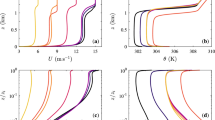Abstract
A new tangential wind profile for simulating strong tropical cyclones is put forward and planted into the NCAR-AFWA tropical cyclone bogussing scheme in MM5. The scheme for the new profile can make full use of the information from routine typhoon reports, including not only the maximum wind, but also the additional information of the wind speeds of 25.7 and 15.4 ms−1 and their corresponding radii, which are usually provided for strong cyclones. Thus, the new profile can be used to describe the outer structure of cyclones more accurately than by using the earlier scheme of MM5 in which only the maximum wind speed is considered. Numerical experimental forecasts of two strong tropical cyclones are performed to examine the new profile. Results show that by using the new profile the prediction of both cyclones’ intensity can be obviously improved, but the effects on the track prediction of the two cyclones are different. It seems that the new profile might be more suitable for strong cyclones with shifted tracks. However, the conclusion is drawn from only two typhoon cases, so more cases are needed to evaluate the new profile.
Similar content being viewed by others
References
Anthes, R. A., 1982. Tropical cyclones: their evolution, structure and effects. Meteor. Monogr. 41. Amer. Meteor. Soc, Boston, 208.
Anthes, R.A., E.Y. Hsie, and Y.H. Kuo, 1987. Description of the Penn state/NCAR mesoscale model version 4 (MM4). NCAR Tech. Note, NCAR/TN 282 + 577?., 66.
Benjamin, S. B., and P. A. Miller, 1990. An alternative sea-Level pressure reduction and a statistical comparison of geostrophic winds estimated with observed surface winds. Mon. Wea. Rev., 118: 2099–2116.
Chan, J.C.-L., and R.T. Williams, 1987. Analytical and numerical studies of the beta-effect in tropical cyclone motion. Part I: Zero mean flow. J. Atmos. Sci., 44: 1257–11265.
Fiorino, M., and R. L. Elsberry, 1989. Some aspects of vortex structure in tropical cyclone motion. J. Atmos. Sci., 46: 979–990.
Fujita, T., 1952. Pressure distribution within a typhoon. Grophys. Mag., 23: 437–451.
Grell, G.A., J. Dudhia, and D. R. Stauffer, 1994. Description of the fifth-generation Penn state/NCAR mesoscale model (MM5). NCAR Tech. Note, NCAR/TN-398+ STR., 107.
Holland, G.J., 1980. An analytic model of the wind and pressure profiles in hurricanes. Mon. Wea. Rev., 104: 1212–1218.
Holland, G.J., and R.T. Merrill, 1984. On the dynamics of tropical cyclone structural changes. Quart. J. Roy. Met. Soc, 110: 723–745.
Klemp, J.B., and D.R. Durran, 1983. An upper boundary condition permitting internal gravity wave radiation in numerical mesoscale models. Mon. Wea. Rev., 111: 430–444.
Kurihara, Y., M. A. Bender, and R.J. Ross, 1993. An initialization scheme of hurricane models by vortex specification. Mon. Wea. Rev., 121: 2030–2045.
Leslie, L. M., and G.J. Holland, 1995. On the bogussing of tropical cyclones in numerical models: a comparison of vortex profiles. Meteor. Atmos. Phys., 56: 101–110.
Meng, Z.Y., Xu, X.D., and Chen, L.S., 2001. A method to study the tangential wind profile for strong tropical cyclones and its contribution to abnormal tropical cyclone track simulation. Chinese J. Atmos. Sci., 25: 193–199 (in Chinese).
Miller, B. I., 1967. Characteristics of hurricanes. Science, 157: 1389–1399.
Myers, V. A., 1957. Maximum hurricane winds. Bull. Amer. Meteor. Soc. 38: 227–228.
Niu, X.X., 1992. Dynamics of Tropical Cyclone. Meteorology Press, Beijing, 306 pp (in Chinese).
Reisner, J., R.J. Rasmussen, and R. T. Bruintjes, 1998. Explicit forecasting of supercooled liquid water in winter storms using the MM5 mesoscale model. Quart. J. Roy. Meteor. Soc, 124: 1071–1107.
Riehl, H., 1963. Some relations between wind and thermal structure of steady state hurricanes. J. Atmos. Sci., 20: 276–287.
Serrano, E., and P. Uden, 1994. Evaluation of a tropical cyclone bogussing method in data assimilation and forecasting. Mon. Wea. Rev., 122: 1523–1547.
Sheets, R. C, 1969. Some mean hurricane soundings.. J. Appl. Meteor., 8: 134–146.
Wang, B., and X. Li, 1992. The beta-drift of three dimensional vortices: A numerical study. Mon. Wea. Rev., 120: 579–593.
Wang, Y. Q., 1998. On the bogussing of tropical cyclones in numerical models: the influence of vertical structure. Meteor. Atmos. Phys., 65: 153–170.
Xiao, Q., X. Zou, and B. Wang, 2000. Initialization and simulation of a landfalling hurricane using a variational bogus data assimilation scheme. Mon. Wea. Rev., 128: 2252–2269.
Zhang, D. L., and R. A. Anthes, 1982. A high-resolution model of the planetary layer-sensitivity test and comparisons with SESAME-79 data. J. Appl. Meteor., 21: 1594–1609.
Zhang, X. Y., B. Wang, Z. Z. Ji, Q. Xiao, and X. Zhang, 2003. Initialization and simulation of a typhoon using 4-dimensional variational data assimilation-research on Typhoon Herb (1996). Advances in Atmospheric Sciences, 20: 612–622.
Zou, X., and Q. Xiao, 2000. Studies on the initialization and simulations of a mature hurricane using a variational bogus data assimilation scheme. J. Atmos. Sci., 57: 836–860.
Author information
Authors and Affiliations
Rights and permissions
About this article
Cite this article
Gao, S., Yang, B. & Wu, Z. A tangential wind profile for simulating strong tropical cyclones with MM5. J Ocean Univ. China 4, 21–28 (2005). https://doi.org/10.1007/s11802-005-0019-1
Received:
Accepted:
Issue Date:
DOI: https://doi.org/10.1007/s11802-005-0019-1




